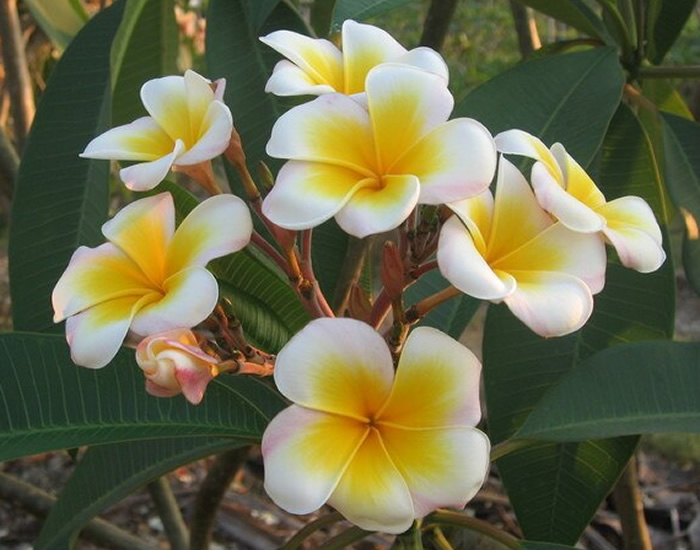
Frangipani Care

Golden Cup
• Frangipani
plants require full sun to grow and flower well.
• They require well drained soil - they don’t like a damp stem
base caused by mulching or lawn clippings around the base of the tree causing
the trunk to rot.
• Fertilise twice a year at the beginning of spring and during summer
with a slow release fertiliser high in phosphate for strong root growth which
will in turn promote the most blooms.
• Water well during the warmer months - leave them to nature in the
cooler months.
• Transplant Frangipani or prune them when dormant in the cooler months.
Frangipani are hardy and forgiving plants which seem to thrive on neglect. However, given regular watering and a fertiliser high in nitrogen, potassium and phosphorous, during the flowering season, they will reward you with more plentiful flowers which are bigger and stronger in colour.
Six hours direct sunlight daily is required for best flowering. Frangipanis are very drought, salt and fire tolerant plants. They respond well to pruning and grow well in large pots. Do not water in winter once established.
Leaves can be affected by fungus, mould and rust. If needed they are best sprayed with a copper based fungicide and whiteoil solution but if the tree is healthy spraying is not necessary.
How to care for your new Frangipani Plants
Upon receiving your plants, they should be potted up and kept in semi shade or full sun in mornings and shade from midday and afternoon until roots can be seen coming out of bottom of pots.
The ideal potting mix, is 40% commercial potting mix and 60% inorganic material such as course sand or perlite or gravel. Commercial potting mixes are generally full of fungus and bacteria which can be harmful to plants.
Always water plants/potting mix with a systemic fungicide and bactericide when potting up your plants.
Frangipani: The Perfect Flower for Australia's Gardens
Inextricably linked to the tropics Plumeria are now being successfully grown in all parts of Australia except the Alpine zones.
Frangipani will grow well in any soil type but prefer a well drained soil. They will grow in all climates except the severe frost prone temperate climates. They prefer and grow best in a hot dry climate. They are very drought and fire hardy. Therefore they are well suited to the Australian climate.
Frangipani: Fertilizing Tips
It is best to keep your frangipanis dry during the cooler months. Frangipanis respond best to organic fertilizers which are high in N.P.K. They love animal manure, fire ash and compost. The best potting mix is any commercial potting mix with 30% sand and some slow release fertiliser added.
Frangipani: How to Prune
The trees respond very well
to pruning and can be kept at a preferred size with regular pruning. Different
pruning approaches can be used to create a compact, densely branched tree
or a standard topiary shrub style with long trunk and no lower branches. To
create a densely branched specimen prune branches to one half or one third
of their natural length.
These pruned branches will sprout multiple branches near the pruned ends.
To prune to produce no branches simply prune branches right back to the main
trunk so that no further branching can occur.
A Well Nourished Plant is a Healthy Plant
Avoid fungal infections by using foliar fungicide sprays. A mixture of powdered milk powder and white oil or detergent has been proven to be most effective against rust and powdery mildew. Keeping plants well nourished helps prevent fungal infections.
Useful Tips for Frangipani Propagation
Propagation of frangipani
is usually from cuttings, which should be dried out for one week in shade
then planted directly into ground or pots of sand. Water only once per fortnight
until roots have developed. Breeders also propagate from seeds or by grafting
or air layering.
______________________________________________Copyright © July 2020___________________________________________________